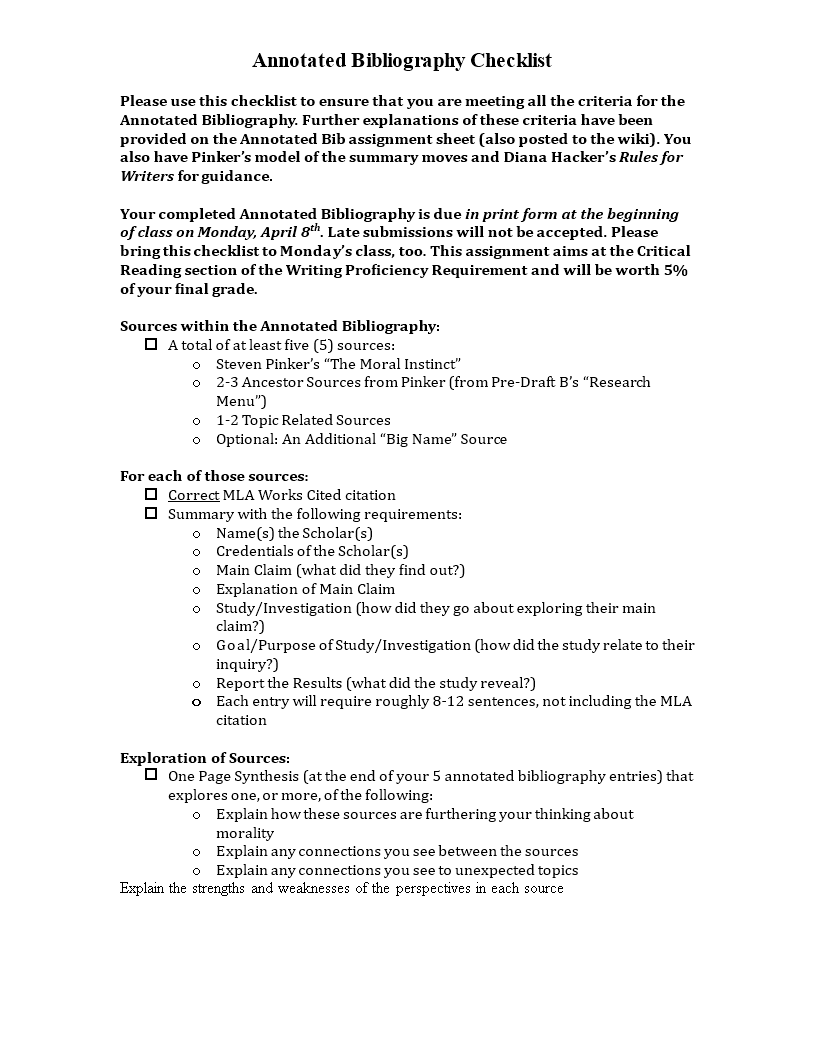Simple Annotated Bibliography Checklist
Save, fill-In The Blanks, Print, Done!

Download Simple Annotated Bibliography Checklist
Microsoft Word (.doc)Or select the format you want and we convert it for you for free:
- This Document Has Been Certified by a Professional
- 100% customizable
- This is a digital download (19 kB)
- Language: English
- We recommend downloading this file onto your computer.
How should an annotated bibliography be structured? Annotated bibliographies should be listed in what order? Download this sample template and fill in the information for each source. Generally, annotated bibliographies should be listed in alphabetical order by author's last name. Get this template now!
An Annotated Bibliography Checklist is a tool used to ensure that each entry in an annotated bibliography meets specific criteria and follows the required format. It helps authors or students systematically review and evaluate each source and its corresponding annotation to ensure accuracy, completeness, and adherence to citation style guidelines.
An annotated bibliography should be structured in a clear and organized manner to provide information about each source and its annotation effectively. The typical structure of an annotated bibliography includes the following elements for each source entry:
- Citation: Begin with the full citation of the source in the chosen citation style (e.g., APA, MLA). The citation includes details such as the author's name, title of the source, publication date, publisher (for books), volume and issue numbers (for journal articles), page numbers (for articles or book chapters), and URL or DOI (for online sources).
- Hanging Indent: Use a hanging indent for each entry. In a hanging indent, the first line of the citation starts at the left margin, and subsequent lines are indented.
- Annotation: Following the citation, include the annotation. The annotation provides a summary and evaluation of the source. It typically consists of several sentences or a short paragraph and covers the following aspects:
- Summary of Content: Summarize the main topics, themes, and key points covered in the source. Highlight the source's methodology (if applicable).
- Key Findings or Arguments: Mention the source's key findings, arguments, or contributions to the topic.
- Relevance to Research: Explain how the source is relevant to your research or the research topic.
- Evaluation: Provide a critical evaluation of the source's quality, credibility, and limitations. Consider the author's qualifications and the source's publication context.
- Reflection: Optionally, include any personal reflections on how the source may be useful in your research.
- Repeat for Each Entry: Repeat this structure for each source you include in your annotated bibliography.
- Alphabetical Order: Organize the entries alphabetically by the author's last name (or title if no author is available).
- Consistency: Maintain consistency in formatting and style throughout the annotated bibliography. Use the same citation style and formatting for each entry.
- Title and Introduction (Optional): Depending on your assignment or guidelines, you may include a title for your annotated bibliography that reflects the topic. An introduction that explains the purpose and scope of the bibliography can also be included.
- Page Numbers (if required): If your assignment or guidelines specify, include page numbers at the top of each page.
- Reference to Citation Style Guide: Provide a reference to the specific citation style guide you used for formatting the entries.
By structuring your annotated bibliography in this way, you provide readers with organized and detailed information about each source while allowing them to quickly understand its content and significance in the context of your research.
Annotated bibliographies should be listed in alphabetical order based on the author's last name or the title of the source (if no author is available). The order provides a systematic and organized way for readers to locate and access the sources within the annotated bibliography.
Using this document template guarantees you will save time, cost, and effort! It comes in Microsoft Office format and is ready to be tailored to your personal needs. Completing your document has never been easier!
Download this Simple Annotated Bibliography Checklist template now for your own benefit!
DISCLAIMER
Nothing on this site shall be considered legal advice and no attorney-client relationship is established.
Leave a Reply. If you have any questions or remarks, feel free to post them below.
Related templates
Latest topics
- GDPR Compliance Templates
What do you need to become GDPR compliant? Are you looking for useful GDPR document templates to make you compliant? All these compliance documents will be available to download instantly... - Google Docs Templates
How to create documents in Google Docs? We provide Google Docs compatible template and these are the reasons why it's useful to work with Google Docs... - IT Security Standards Kit
What are IT Security Standards? Check out our collection of this newly updated IT Security Kit Standard templates, including policies, controls, processes, checklists, procedures and other documents. - Letter Format
How to format a letter? Here is a brief overview of common letter formats and templates in USA and UK and get inspirited immediately! - Google Sheets Templates
How to work with Google Sheets templates? Where to download useful Google Sheets templates? Check out our samples here.
cheese

